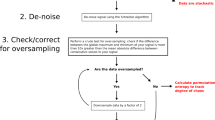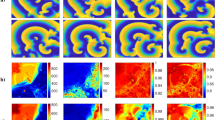Abstract
Mathematical “chaos” appears to occur in the heartbeat time-series. Low-dimensional chaos can be visualized as a geometric or spatial pattern in a temporal process. Several methods are available for representing these geometric patterns, including the mutual information content, the correlation dimension, and the type of pattern recurrences. Application of these methods to the heartbeat following coronary artery occlusion shows that prior to the initiation of lethal arrhythmogenesis the mutual information increases, the correlation dimension decreases, and the recurrence patterns shift from periodic clustering to local clustering. These observations not only have implications for new theoretical approaches to understanding how the heartbeat is generated and how arrhythmias occur, but also for the development of new biomedical tests and the manufacture of new devices for use in clinical cardiology.
This is a preview of subscription content, access via your institution
Access options
Subscribe to this journal
Receive 12 print issues and online access
$209.00 per year
only $17.42 per issue
Buy this article
- Purchase on Springer Link
- Instant access to full article PDF
Prices may be subject to local taxes which are calculated during checkout
Similar content being viewed by others
References
Mandelbrot, B. 1982. The Fractal Geometry of Nature. WH Freeman San Francisco
Takens, F. 1985. On the numerical determination of the dimension of an attractor. Lecture Notes in Mathematics. Springer-Verlag Berlin. 1125: 99–106.
Goldberger, A.L., Rigney, D.R., Mietus, J. Antman, E.M. and Greenwald, S. 1988. Nonlinear dynamics in sudden cardiac death syndrome: Heartrate oscillations and bifurcations. Experientia 44: 983–987.
Stambler, B.S., Morgan, J.P., Mietus, J., Moody, G.B., Rigney, D.R. and Goldberger, A.L. 1989. Distinctive heart rate dynamics precede cocaine induced sudden death. J. Mol. Cell. Cardiol. 21(Suppl II): 5–16.
Goldberger, A.L., Rigney, D.R. and West, B.J. 1990. Chaos and fractals in human physiology. Sci. Am. 262: 42–49.
Furman, M.I. Kaplan, D.T., Ryan, S.M., LipsitZ, L.A. and Goldberger, A.L. 1990. A nonlinear parameter measures loss of complexity in heat rate time series with aging. Clin. Res. In press.
Goldberger, A.L. and Rigney, D.R. Nonlinear dynamics at the bedside. 1990. In: Theory of Heart. Glass, L., and Hunter P. (Eds.). Springer-Verlag Berlin. In press.
Haken, H. 1983. Advanced Synergetics. Springer-Verlag Berlin.
Fraser, A.M. and Swinney, H.L. 1986. Independent coordinates for strange attractors from mutual information. Phys. Rev. 33: 1134–1140.
Grassberger, P. and Procaccia, I. 1983. Measuring the strangeness of strange attractors. Physica 9D: 189–208.
Mayer-Kress, G. (Ed.). 1986. Dimensions and Entropies in Chaotic Systems. Springer Series in Synergetics, Vol. 23. Springer-Verlag, Berlin.
Mayer-Kress, G. and Layne, S.P. 1987. Dimensionality of the human electroencephalogram. Ann. of the New York Acad. of Sci. 504: 62–86.
Mayer-Kress, G., Yates, F.E., Benton, L., Keidel, M., Tirsch, W., Pöoppl, S.J. and Geist, K. 1988. Dimensional analysis of nonlinear oscillation in brain, heart and muscle, Mathematical Biosciences 90: 155–182.
Zbilut, J.P., Mayer-Kress, G., Sobotka, P., O'Toole, M. and Thomas, J.X. 1990. Chaotic heart rate dynamics in isolated perfused rat hearts, Biol. Cybernetics, In press.
Skinner, J.E., Carpeggiani, C., Landisman, C.E. and Fulton, K.W. 1990. The correlation dimension of the heartbeat intervals is reduced in conscious pigs by myocardial ischemia. Circ. Res. Submitted.
Eckmann, J.P., Kamphorst, S.O. and Ruelle, D. 1987. Recurrence plots of dynamical systems. Europhysics Letters 4: 973–977.
Farmer, J.D. and Sidorowich, J. 1988. Exploiting chaos to predict the future and reduce noise, p. 1–50. In: Evolution, Learning and Cognition. Lee, Y.C. (Ed.). World Scientific Publishing Co. Singapore.
Hübler, A. and Lüscher, E. 1989. Resonant stimulation and control of nonlinear oscillators, Naturwissenschaften 76: 67–69.
Mayer-Kress, G. and Hübler, A. 1990. Time evolution of local complexity measures and aperiodic perturbations of nonlinear dynamical systems. In: Quantitative Measures of Complex Dynamical Systems. Abraham N. B. (Ed.). Plenum Press, NY. In press.
Ebert, P.A., Vanderbeck, R.B., Allgood, R.J. and Sabiston, D.C., Jr. 1970. Effect of chronic cardiac denervation on arrhythmias after coronary artery ligation. Cardiovascular Res. 4: 141–147.
Skinner, J.E. and Reed, J.C. 1981. Blockade of a frontocortical-brainstem pathway prevents ventricular fibrillation of the ischemic heart in pigs. American Journal of Physiology 240: H156–H163.
Kitney, R.I. 1987. Beat-by-beat interrelationships between heart rate, blood pressure, and respiration, p. 164–178. In: The Beat-by-Beat Investigation of Cardiovascular Function. Kitney, R. I., and Rompel-man, O. (Eds.) Clarendon Press, Oxford.
Mulder, L.J.M. and Mulder, G. 1987. Cardiovascular reactivity and mental work-load, p 216–267. Ibid.
Tavazzi, L., Sotti, A.M. and Rondanelli, R. 1986. The role of psychologic stress in the genesis of lethal arrthymias in patients with coronary artery disease. Eur. Heart J. 7(Suppl A): 99–105.
Skinner, J.E., Lie, J.T. and Entman, M.L. 1975. Modification of ventricular fibrillation latency following coronary artery occlusion in the conscious pig: the effects of psychological stress and beta-adrenergic blockade. Circulation 51: 656–667.
Skinner, J.E. 1985. The regulation of cardiac vulnerability by the cerebral defense system. J. Amer. Coll. Cardiol. 5: 88B–94B.
Kleiger, R.E., Miller, J.P., Bigger, J.T., Moss, A.J. and Multicenter Post-infarction Research Group. 1987. Decreased heart rate variability and its association with increased mortality after acute myocardial infarction. Am. J. Cardiol. 59: 256–262.
La Rovere, M.T., Specchia, G., Mortara, A. and Schwartz, P.J. 1988. Baroreflex sensitivity, clinical correlates and cardiovascular mortality among patients with a first myocardial infarction: a prospective study. Circulation 78: 816–824.
Rahe, R., Bennette, L., Romo, M., Siltanen, P. and Arthur, R.S. 1973. Subjects' recent life change and coronary heart disease in Finland. Am. J. Psychiat. 130: 1222–1226.
Winfree, A.T. 1987. When Time Breaks Down: The Three-Dimensional Dynamics of Electrochemical Waves and Cardiac Arrhythmias. Princeton University Press, Princeton, NJ.
Chen, P.-S., Shibata, N., Dixon, E.G., Martin, R.O. and Ideker, R.E. 1986. Comparison of the defibrillation threshold and the upper limit of ventricular vulnerability. Circulation 73: 1022–1028.
Ideker, R.E., Smith, W.M., Wolf, P., Danieley, N.D. and Bartram, F.R. 1987. Simultaneous multichannel cardiac mapping systems. PACE 10: 281–292.
Han, J. and Moe, G.K. 1964. Nonuniform recovery of excitability in ventricular muscle. Circ. Res. 14: 44–60.
Shibata, N., Chen, P.-S., Dixon, E.G., Wolf, P.D., Danieley, N.D., Smith, W.M. and Ideker, R.E. 1988. Influence of shock strength and timing on induction of ventricular arrhythmias in dogs. Am. J. Physiol. 255: H891–H901.
Chen, P.-S., Wolf, P.D., Dixon, E.G., Danieley, N.D., Frazier, D.W., Smith, W.M. and Ideker, R.E. 1988. Mechanism of ventricular vulnerability to single premature stimuli in open chest dogs. Circ. Res. 62: 1191–1209.
Frazier, D.W., Wolf, P.D., Wharton, J.M., Tang, A.S.L., Smith, W.M. and Ideker, R.E. 1989. Stimulus-induced critical point: Mechanism for the electrical initiation of reentry in normal canine myocardium. J. Clin. Invest. 83: 1039–1052.
Winfree, A.T. 1983. Sudden cardiac death. Sci. Am. 248: 144–161.
Rosenshtraukh, L.V., Zaitsev, A.V., Fast, V.G., Petson, A.M. and Krinsky, V.I. 1989. Vagally induced block and delayed conduction as a mechanism for circus movement tachycardia in frog atria. Circ. Res. 64: 312–226.
Skinner, J.E., Beder, S.D. and Entman, M.L. 1983. Psychologic stress activates phosphorylase in the heart of the conscious pig without increasing heart rate and blood pressure. Proc. Nat. Acad. Sci. USA. 80: 4513–4517.
Author information
Authors and Affiliations
Rights and permissions
About this article
Cite this article
Skinner, J., Goldberger, A., Mayer-Kress, G. et al. Chaos in the Heart: Implications for Clinical Cardiology. Nat Biotechnol 8, 1018–1024 (1990). https://doi.org/10.1038/nbt1190-1018
Issue Date:
DOI: https://doi.org/10.1038/nbt1190-1018
This article is cited by
-
Wavelet-Based Multiscale Sample Entropy and Chaotic Features for Congestive Heart Failure Recognition Using Heart Rate Variability
Journal of Medical and Biological Engineering (2015)
-
Forebrain regulation of cardiac function spectral and dimensional analysis of RR and QT intervals
Integrative Physiological and Behavioral Science (1993)
-
Low-dimensional chaos maps learning in a model neuropil (olfactory bulb)
Integrative Physiological and Behavioral Science (1992)
-
Application of chaos theory to biology and medicine
Integrative Physiological and Behavioral Science (1992)



